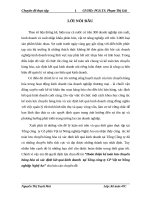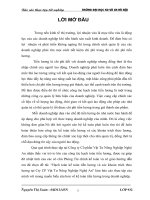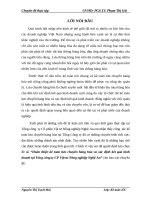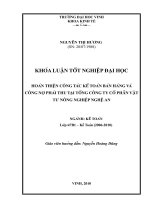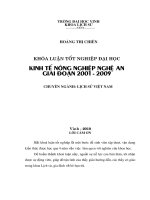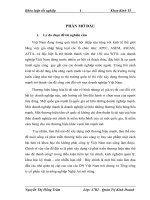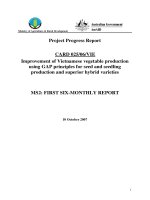Dự án nông nghiệp " Nghe An Province Sustainable Village Based Beef Cattle Development, Training and Extension Programme " - Project Progress Report SECOND SIX-MONTHLY REPORT pdf
Bạn đang xem bản rút gọn của tài liệu. Xem và tải ngay bản đầy đủ của tài liệu tại đây (163.5 KB, 20 trang )
Ministry of Agriculture & Rural Development
Nghe An Province
Sustainable Village Based Beef Cattle
Development, Training and Extension
Programme
Project Progress Report
SECOND SIX-MONTHLY REPORT
October 2007
Table of Contents
1
Institute Information .........................................................................................................1
2
Project Abstract..................................................................................................................2
3
Executive Summary...........................................................................................................2
4
Progress to Date.................................................................................................................3
Implementation Highlights ............................................................................................................................ 3
Smallholder Benefits...................................................................................................................................... 4
Capacity Building .......................................................................................................................................... 5
Publicity......................................................................................................................................................... 5
Project Management ...................................................................................................................................... 5
5
Report on Cross-Cutting Issues ........................................................................................6
Environment................................................................................................................................................... 6
Gender and Social Issues ............................................................................................................................... 6
6
Implementation & Sustainability Issues...........................................................................6
Issues and Constraints.................................................................................................................................... 6
Intervention Options ...................................................................................................................................... 7
Sustainability ................................................................................................................................................. 7
7
Next Critical Steps .............................................................................................................7
8
Conclusion .........................................................................................................................8
9
Statutory Declaration .......................................................... Error! Bookmark not defined.
Annex 1 - Project Progress Against Proposed Objectives, Outputs, Activities And Inputs .12
1
1 Institute Information
Project Name
Nghe An Province, sustainable village
based beef cattle development, training
and extension project.
Vietnamese Institution
19 May Fruit & Vegetable Co
Vietnamese Project Team Leader
Mr Diep
Australian Organisation
AusAID
Australian Personnel
Mr Tim Harvey
Date commenced
February 2007
Completion date (original)
December 2009
Completion date (revised)
-
Reporting period
First six months
Contact Officer(s)
In New Zealand: Team Leader
Mr Tim Harvey
Name:
Director
Position:
Organisation Massey University
Telephone:
Fax:
Email:
00 64 6 350 5119
00 64 6 350 5633
In New Zealand: Administrative contact
Name:
Mr M Peters
Director
Position:
Organisation Research Management
Services
Telephone:
Fax:
Email:
In Vietnam
Mr Toan
Name:
Project Coordinator
Position:
Organisation BCFRC
Telephone:
Fax:
Email:
00 64 6 350 5799 Extn
81338
00 64 6 801 2682
2
Project Abstract
The Beef Cattle Development Plan for 2010 (No1155/QD-UB Nghe An) was introduced in
May 2003. The plan set objectives to increase beef production, use crossbreeding to
introduce new breeds and improve rural incomes. The traditional VN beef industry is based
on very small household farmlets, grazing waste land; this model has proved unsustainable.
This project will look at developing a sustainable, economic village based beef farming
model to improve long-term meat supply, and improve incomes. This project will design,
implement and evaluate the village based beef farming system in the Nghe An Region. The
project will be based around a small nucleus (demonstration) farm and three rural villages,
which have below average household income levels (Nghia Lam, Nghia Son and Nghia
Quang).
The project will train five technical trainers (ToT’s) to build institutional capacity and
strengthen the local extension services and technicians in forage, animal nutrition, animal
husbandry and breed improvement. Collaborators from New Zealand and Australia will
work with Local Farmers, 19th May Co, BCFRC and the local Extension Service to
evaluate new technologies into the use of bi-products thereby increasing nutritional levels
and establishing “Best On-Farm Practices” procedures for this region’s Beef Industry
3 Executive Summary
Introduction & Background Introduction:
Over the last 6-months two project visits have been completed (July & September).
The July 07 visit involved Dr Phil Rolston, Dr Michael Hare and Mr Tim Harvey. This visit
was successful with the main objectives being achieved. Nine farmers were selected,
contracts signed, 3 electric chopping machines designed and manufactured locally; 6 new
species of tropical pasture and legumes identified for use; and bi-products and crop residue
silage made.
The September 07 visit involved Dr Michael Hare, Mrs Averill Ramsey-Evans and Mr Tim
Harvey. The visit completed the inception phase of the project as well as the base data
collection.
The visit also finalised arrangements for the purchase of AI equipment and semen from Vinh
City; analysis of silage; evaluation of pasture species and the setting up of a cattle computer
data base for the project cattle.
There has been good buy-in from the 9 key farmers and interest from other small holders in
the results. The 19 May Company administration support for the project has been very good;
however, there have been delays in establishing the Nucleus Beef herd, which is causing
concern.
2
Cross Cutting Issues:
It is estimated that only 20% of the breeding age female cattle in the 3-project villages are
Red Sindhi Cross.
This low % will slow the introduction of Brahman and Droughtmaster breeds. The local
yellow cattle are very small and it is the projects recommendation that only female cattle that
are second calvers and have some Red Sindhi breeding be mated to Brahman and
Droughmaster
Hopefully good AI results can be achieved (through good training), with high conceptions so
farmers can see the long-term benefits of the breeding programme.
The pineapple processing factory is having difficulty with supply of product and this is
making the supply of crop residue pulp difficult to obtain.
The 19 May Company is having difficulty obtaining funding for development of its nucleus
beef unit and there is a lack of experience and expertise within the company
4 Progress to Date
Implementation Highlights
The introduction of new pasture species of grasses and legume from Thailand. Dr Michael
Hare from Ubon Ratchathani University introduced Mulato II, Ubon Paspalum and Ubon
Stylo. Demonstration plots and project farmer nurseries have been established for evaluation.
Both Mulatto II and Ubon paspalum produced approximately 20 tonne of wet matter in 60days from planting. Gross wet matter production will be monitored over the next 12 months.
The successful organisation and participation of 30 farmers and technicians in an in-country
3-day training workshop at BCFRC training centre at Bavi. This provided project farmers the
opportunity to discuss with successful farmers around Bavi on the development of pasture
based cattle systems, as well as receiving detailed instruction on nutrient requirement,
reproduction and cattle management.
The project sent a 19th May Company technician for training in AI, to support the project and
the nucleus herd. Mr Ming had training for 35-days at a national AI training course held at
BCFRC along with 25 other technicians from around Vietnam. This was a great opportunity
for capacity building, not only in AI technology but also in overall cattle management and
extension methods.
The successful construction of small scale silage chopping machinery and purchase of “well
liners” for making silage. Three electric “single phase” chopping machines and 6 smaller
electric choppers were designed and built locally for the project. These choppers have proved
suitable for project farmers with village and household electricity systems being robust
enough to operate the machines. These machines chop approximately 100-200 kg/hr.
The silage “well liners” purchased as small tanks for small farmer based silage making have
proved excellent for this application.
For 200,000 dong ($US 12) they have proved
economical and a lot more sustainable than large plastic bags. The “well liners” hold
3
approximately 150 -180kg of wet matter, are easily compacted, very robust, easy to cover and
totally reusable. While the size is a little small; it is available locally using existing moulds.
The farmers in the district had no previous experience in silage making. 15 “well liners” of
silage were made in July 2007, 10 liners were excellent with high quality fermentation; 3
liners were OK and usable and 2 liners were poor quality, due to poor compaction and poor
sealing of the liner (water and air entering the liner). 8 out of 9 project farmers were very
pleased with the technology and 4 silage samples will be sent for analysis at Hanoi to
determine protein etc.
The following types of silage have been made to date:
Elephant grass with additives (molasses, salt & rice bran)
Elephant grass and cassava leaf with additives
Cassava leaf and green maize stover with additives
Elephant grass and dry maize stover with additives
Green maize (cob in) with additives
Sugarcane top with additives
Pineapple pulp and dry maize stover with additives
The introduction of data recording – all the key project farmers cattle have been ear tagged
and liveweights (LWT) recorded to provide a base situation. The animal pedigrees have been
collected (where known) and recorded for future updating.
A new beef cattle recording system (Australian based) is being trailed by the NZ team. This
programme records owner, location, all cattle information and veterinary events. If the
programme is robust enough, consideration will be given to its introduction and translation to
Vietnamese.
The project team has visited the National AI centre in the Ha Tay Province and identified Red
Brahman, Droughtmaster and Red Angus as suitable breeds for introducing into the project
region. Arrangements are being made to purchase some extra AI equipment (in-country) as
well as semen for the project.
The calibre of the 9 key farmers selected for the project has been very good and encouraging.
All farmers have been willing to support the project and attend training on a regular basis. It
is pleasing to see the level of cooperation and high trust levels that have developed over the
last 8-months of the project.
Smallholder Benefits
The small holders are starting to get direct benefit from the project. At present this is mainly
the 9 key farmers involved in the implementation of focus farmers. The small holders have
received small chopping machines and well liners, all their cattle have been tagged and
recorded and weighed. All key farmers have been trained in silage making and have made
silage on their own properties.
The small holders have access to new beef breeds (Brahman and Droughtmaster) and one
experienced and one newly trained AI technician are located at the project site to undertake
AI. Non-key project farmers will have access to new beef breeds through AI.
4
Small holders have been given new varieties of pasture seed. Most have established nursery’s
so the varieties of Mulato II and Ubon Paspalum can be multiplied up in the district (this is
the first importation and evaluation of these species into Vietnam).
Small holders have been involved in workshops and training with 30 technicians being trained
at BCFRC in Bavi in Sept/Oct 2007.
Capacity Building
The 19th May Company is being exposed to international experience in administration and
management of projects. This has included international money transfer, importation of
product and overall organisation.
One new AI technician, (from 19th May Company) has been trained in cattle AI and
reproduction management. This technician will provide much needed experience to the
project and other technicians.
The Nghia Dan Extension Services has been involved in training and providing support to the
project. This is the first time these technicians have been involved directly in an international
Aid project.
The NZ team have visited:a The Vinh City Nghe An provincial Animal Breeding & Research Centre
b The MART Animal Breeding Semen and Equipment Centre
c The Son Tay National Animal Breeding and Bull Centre
d Goat & Rabbit Research Centre, Son Tay, Ha Tay Province
e Nghia Dan Extension Office
All these visits and discussions assist in exposing staff to the project and international
standards.
The techniques of pasture assessment and cattle, body condition scoring has been introduced
to the region.
Publicity
The local Nghe An TV company visited the project site and undertook a short segment on the
project (19 September 2007)
The project appeared in the CARD newsletter in August 2007.
The project support a Nghia Son Village mid-autumn children’s “Moon Festival” on the 25
September 2007.
Project Management
The project management is working well; with excellent support from the project coordinator
Mr Toan and good support from the 19th May Company Mr Deip and administrative team.
The NZ team is working well and Dr Michael Hare has provided very good input into the
project at a cost effective rate (i.e. being located in Thailand). The project is working within
5
its budget. The fluctuation in the exchange rate between Australia – US – NZ- VN currency
makes budgeting a challenge.
Some savings have been made on semen, by sourcing all products within Vietnam at the local
price. AI equipment has also been sourced locally imported from China.
The biggest concerns at present are:
Assisting the 19th May Company to develop an internationally accepted beef
model farm without direct finance capital support.
The cost of international airfares and in-country transport costs.
5 Report on Cross-Cutting Issues
Environment
Due to the difficulty of supply, silage making from cassava pulp and pineapple pulp waste has
not been implemented other than one sample well liner. Therefore it is hard to evaluate the
longer-term reduction of waste bi-products at these plants. Given the size of these two
operations the issues of waste disposal may be better address through the development of a
bio-fuel industry.
Acid leaching from the silage “well liners” has been monitored and to date no leachates have
been detected and there has been no waterways contaminated.
Silage making is likely to have a positive effect on the environment; the ensiling process
increases the digestibility of the crop residues and therefore improves the availability and
utilisation and available as nutrients back into the soil.
An increase in beef cattle numbers may increase green house gas admission, however, this is
likely to be very small compared to industry expansion in Vietnam.
Gender and Social Issues
Silage making to date has been making considered “mans” work with men doing the majority
of cutting and carrying of product.
The operation of the machinery mainly involves men, however, it seems to be the women
who feed the cattle and it is women who have commented on its suitability etc.
To date no negative social issues have been detected that can be associated directly to the
project. The most positive social aspect has been the acceptance of the NZ team in the Nghia
Son Village. The NZ team live and work from the 19th May Company at Nghia Son.
The children are very interested and they talk to the NZ team. The local school teacher has
used the opportunity to practice English
6 Implementation & Sustainability Issues
Issues and Constraints
The supply of pineapple pulp for silage making is unreliable as the factory lack raw product
supply. The Company also has some financial issues that may affect sustainability.
6
The 19th May Company has had major issues with the cattle management. This has been
disappointing for the director (Mr Deip) how has worked hard to correct the situation;
however, it has delayed purchase of the company’s nucleus herd. This issue is slowly being
resolved with cattle arriving in October 2007. However, the company still has to demonstrate
that it has the ability to manage a modern nucleus herd of beef cattle.
Communication with the key project farmers can be difficult at times; especially if the
communication channel is through the village administration. The project now has a full list
of farmers contact details.
Intervention Options
The list of interventions (see intervention report) has highlighted a wide range of
opportunities to develop the beef industry and benefit the small holders.
Inter-planting between orange trees with legume based cover crops is likely to have beneficial
effects and well worth evaluating.
The introduction of Mulato II and Ubon Paspalum gives the small holder the opportunity to
develop a seed/seedling base production system, and therefore growing and marketing the
new pasture varieties within the district.
The availability of crop residue is very high – especially cassava leaves over the autumn
period. Silage made from fresh maize stover (or elephant grass) and cassava leaf is looking
very promising and could provide a good quality feed source over the dry period.
Sustainability
It is important that the project evaluates as wide a range of crops and crop residue options for
silage making. If the cassava factory or other processors of crops change, the crop residue
source could be lost. If we can evaluate a range of alternatives the risk will be reduced
The risk of foot and mouth in Vietnam remains high. The project would have a major set
back if a foot and mouth outbreak occurred in the Nghia Dan District.
Marketing of beef cattle is not well developed in the region and the project will have to
evaluate this aspect in the future.
7 Next Critical Steps
Get the 19th May Company nucleus herd established and managed effectively
Organise a training trip to Ubon Ratchathani University in Thailand for 11
farmers and technicians to visit a tropical region that is using new varieties of
pasture for beef production.
Complete collecting the last of the base data from all the farmers
Evaluate the effectiveness of the AI programme for new beef sires. Monitor
conception rate and semen quality.
Obtain analysis of the silage made from a range of different products.
Undertake the first NZ Training trip in November 2007.
Complete all the reports for phase one of the project.
7
Arrange for the next visit to the project by the NZ Team in March 2008.
8 Conclusion
The project is meeting its objectives and the introduction of new pasture species into Vietnam
is exciting. The training programme for farmers and technicians is going well with over 70
hours of training so far, involving approximately 225 participants.
Planning is well advanced for training in Thailand and in New Zealand and it is hoped that the
difficulties in establishing the Nucleus herd within the 19 May Company can be over come by
the end of this year.
8
9
10
11
Annex 1 - Project Progress Against Proposed Objectives, Outputs, Activities And Inputs
VIE
Narrative
10/06
Objective Design and implement a village
1
based beef production farming
system in three rural villages with
below average income levels
(Nghia Lam, Nghia Son and Nghia
Quang) by Dec 2009
Performance Indicator
Three village based beef
farming groups established
with 9 farmers involved (3x3)
as Project Focus Farmers
(PFF)
Means of
Verification
Farmers actively
involved in the
project and cattle
monitoring started
Assumptions/Risks
Update after visit
Risks-The families selected
to form the PFF’s don’t have
the capital and land
resources required. Delays
in cow purchase to make up
cow numbers.. Lack of
suitable feed within the first
6 months before new
technologies put in place
Risks-Lack of understanding
of the project structures by
Village families and leaders.
List of farmers from 3
villages given to village
leaders to select PFF. 23
farmers interviewed and
base data collected on all
Village based beef production
farming system structures enhanced
and model farms developed and
established within nine months of
the project start
Undertake baseline survey on
social, resources, feed production,
animal production and financial
situation in project area. .
9 PFF’s involved with approx
36 cattle under new
management
Agreements in place
and signed.
Information collected and put
into report
Data captured and
reported back to the
farmers
Lack of information held in
Extension centre
Activity
1.1.2
Project work with Farmer assoc and
farmers to select PFF’s
9 PFF selected and farmers
visited by project team
Trip reports presented
Activity
1.1.3
Undertake a beef farming training
needs analysis with the stakeholders
and farmers to identify training
needs and skill gaps
Run 2 workshops for beef
farming training need analysis
with farmers and technicians
and extension offices
Training needs
written down and
translated.
Activity
1.1.4
Facilitate 15 x 1 day technical
workshops using interactive
methods at villages (on-farm) and
training centres
Assist PFF’s to plant new species,
in trial plot of 400 m2
Knowledge up take and
increased per cow
performance
Number of trainees
attending. Trainees’
involvement. Milk
production monitored
Area plantedx9
Risks- Lack of consensus,
lack of local leadership.
Delay due to weather or
other factors
There are knowledge gaps,
farmers can identify there
skill gaps. Resources are
available, skills are available
within the team to cover the
skill gaps
Lack of commitment by
farmers, poor translation or
understanding
Output
1.1
Activity
1.1.1
Activity
1.1.5
400m2 of new grasses planted
and growing
Lack of land, poor farmer
understanding, lack of
water, fertiliser
Completed 9 Key Farmers
operational
Base line data collected
from villages, more detailed
information will be collected
from the 9 PFF over Oct
Nov 2007
Completed 9 Key Farmers
operational
Workshop completed and
needs analysis undertaken
technical workshops
undertaken on silage and
nutrient balancing (see
training summary
small trial plots planted.
12
Activity
1.1.6
Assist PFF’s to make silage and
conserve feed,
Activity
1.1.7
Activity
1.1.8
Take silage samples for analysis
Activity
1.1.9
Undertake project visits . Write and
submit reports, finalise back to back
agreements, and maintain an
effective project administration
system
Silage successfully made on 9
PFF’s farms
Silage made on 9
PFF’s farms
5 samples analysed for CP CF, Results obtained
ME
Develop feed and production system evaluation and reports for each technology intervention
the project puts in place
Successful visits Reports
delivered, agreements signed,
Visits complete
Weather, right people
available at the right time
Transport
Project managers time
management. Translation
delays Travel restrictions
due to Avian flu
Silage well-liners designed
and built 3 for each PFF
and 12 trial ones for 19 May
co. Silage made
First samples taken
Reports developed on
interventions plans (see
report)
Conception report written,
13
Objective Train five technical trainers and 5
2
Farmer trainers (ToT; ToF) to build
institutional capacity and strengthen
the local extension services, farmers
and technical expertise in forage,
animal nutrition, animal husbandry
and animal breeding by Dec 2009
5 ToT; ToFs identified and
profiles evaluated. ToT; ToFs
trained in modern PRA
method and objectively
evaluated both in the field and
through written projects.
Projects complete,
ToT; ToF’s pass
evaluation and are
presented with a
certificate
That a balance of gender can
be achieved. Education
background suitable for
ToT; ToF roles. Time
commitment high to not
only complete Training but
have ongoing input
There are knowledge gaps,
technicians and stakeholders
can identify there skill gaps.
Resource are available,
skills are available within
the team to cover the skill
gaps
Time commitment by
technicians and extension
offices
Output
2.1
A training and knowledge extension
capability needs analysis
undertaken with technicians and
stakeholders within 6 months of the
project start.
Training needs identified and
understood by all stake
holders. Training needs
developed into a training
programme
Training needs
written down and
translated.
Activity
2.1.1
Run 1 workshops for training need
analysis with technicians and
extension offices
Training and extension needs
identified and understood by
all stake holders.
Workshop held.
Number and
attendees
Activity
2.1.2
Complete training programme in
extension methods for the project
and technical manual translated
Five technical trainers and Farmer
trainers (ToT, ToF) selected (at
least one from the ABC) and
trained on extension methods by
January 2008
All training areas identified
Programme complete
and ready for
implementation
Certificates of
compliance and
completion issued by
participating
Institutes
Output
2.2
Five ToT; ToF’s selected,
trained, evaluated and
presented with certificates of
completion.
There are not 5 animal
husbandry technicians in the
project site. 1 district and 3
19 May Co technicians have
been identified. Only 2 out
of three villages have farmer
technicians, with the third
village yet to appoint a
farmer technicians. This
should not affect
inplemmentation of the
project but may limit
extension to other villages.
This factor will need to be
discussed with district
officials and CARD office
Training needs analysis
complete see report
Undertaken, and level of
understanding and training
need identified for some
areas
Commitment and suitable
people involved
Given the high male
dominance in the animal
husbandry area, gender
balance will be an issue.
Language barrier may hinder
knowledge up-take. It will be
important to ensure
availability and funding of
ToT; ToF’s to ensure
continued capacity building
after the end of the project
There are not 5 animal
husbandry technicians in the
project site. 1 district and 3
19 May Co technicians have
been identified. Only 2 out
of three villages have farmer
technicians, with the third
village yet to appoint a
farmer technician. This
should not affect
implementation of the
14
project but may limit
extension to other villages.
This factor will need to be
discussed with district
officials and CARD office
Activity
2.2.1
Activity
2.2.2
Husbandry Extension Services,
BCFRC and 19th May Company to
identify and select trainees after the
first visit
Run 2 extension methodology
workshops with ToT; ToF’s
Five ToT; selected with gender Agreement in place
balance of high calibre and
with parent Institutes
commitment to the project.
of the ToT;
Increase in training ability and
up-take of technology
Each ToT; ToF will
be evaluated and
assessed at the end of
each workshop and
provided with
feedback.
Activity
2.2.3
Involve all ToT; ToF’s in technical
training at the village level.
Selecting ToT’s technical modules
to deliver in an environment where
they can be supported and evaluated
by the project team
Each ToT delivers 5 modules
in a village based training
environment covering a range
of technical subjects.
Evaluation sheets
completed for each
ToT; ToF
Activity
2.2.4
Evaluate and measure up-take of
knowledge by ToT’s and issue
certificates of competence and
completion
All five ToT’s reach
competence levels both in
training methodology as well
as in beef systems
technologies
Five certificates
issued
Trainees implement
knowledge gained from
training on home farms.
Increase in
production
Objective Increase technical knowledge and
3
improve capacity in key
stakeholders, technicians and
leading farmers through overseas
training experience in NZ and
China
Lack of down stream
funding, infrastructural
capacity, resources and
quality technicians
Modern western teaching
methods are very different
from traditional Asian
training, therefore trainees
will need to be able to have
the ability to operate in a
participatory way using a
range of multi-media
resources
Finding ToT’s with strong
animal husbandry
backgrounds especially in
beef may be difficult as well
as the fact that the project
team will be also learning on
the job
The certificates issued are
not academic qualifications
and therefore assessment
and evaluation will be
subjective and will be
undertaken internally by the
project team.
Trainee’s will hold positions
that will allow transfer of
knowledge directly back to
the project site
To be completed, more input
needed
Visit 3
2 technicians involved in
participatory farmer
interviews and some
capacity building
undertaken
Visit 4
Still under consideration to
where the best training sites
are for the project. One
training planned at the
Bavi BCFRC. It is planned
to take a group of 10 to
Thailand for specialised
training
15
Output
3.1
Identify key technical capacity gaps
with key stakeholders within the
first 6 months of the project
An innovative training
programme developed and a
balanced team of trainee’s
selected
All trainees selected
A gender balance may be
hard to achieved
Activity
3.1.1
Write up technical capacity gaps
and develop training programs for
in-country and Massey Scholarships
Identify training participants and
with approval from project leaders
and CARD
Undertake in-country training visit
and Massey Scholarship training
and evaluate training
Take 3 trainees to NZ for training
for 1-2 months
Take 3 leaders Australia for training
and exposure to tropical farming
methods
Programme approved by
project team.
Written programme.
Sign off by project team and
CARD
Sign off
High level of knowledge uptake.
Evaluation
undertaken
Capacity gaps too wide and
lack of skill level to benefit
from experience
This will be a consensus
issue for some key
stakeholders
Visa’s maybe hard to get,
transfer of funds
All trainees complete training
successfully
All farmers and technicians
complete training and
evaluation forms.
A Massey Certificate
issue to each trainee
Trip complete travel
report sent to CARD
Visa’s maybe hard to get,
transfer of funds
Coordination within
Australia
Activity
3.1.2
Output
3.2
Activity
3.2.1
Activity
3.2.2
Activity
3.2.3
Activity
32.4
Activity
3.2.5
Take 3 in-country training visits for farmers and technicians for training and exposure tonew technologies and tropical
farming methods
Set each Massey Scholarship
Project presentations to project Complete trainee
Lack of commitment,
participant a project to complete
team
evaluation forms and trainee see trip as holiday,
over the training period and present
rank, and copy to
report not completed
it to the project team at the end of
CARD
training
Project team to provide a written
Assessments completed and
Complete trainee
Lack of commitment,
assessment of each training visit
presented to participants.
evaluation forms and trainee see trip as holiday,
rank, and copy to
report not completed
CARD
Key gaps identified, ie
tropical pasture species,
pasture management,
nutrient balancing silage
making and
use/conservation of biproducts.
Technical gaps identified,
training programme still to
be finalised
to be completed
first Massey trainee
identified and will undertake
training in Oct 2007
see above
This is under consideration
and to be finalises when
better understanding is
obtained
First training complete at
Bavi
N/A
N/A
16
Objective Provide technical assistance and
4
training for the establishment of
a “best practice” 50 cow model
farm on 19th May Co land. The
model farm to act as a nucleus
for provision of breeding males
as well as a coordinator and
facilitator of “best practice”
Code of Practice for “Best
Practice” developed.
Breeding program in place.
Good buy-in from staff.
High profile and visitor
number to maximise
extension
Farm established and There is lack of skill at all
production target met. levels. Even simple
animal handling
Output
4.1
Identify key technical capacity gaps
and undertake a needs analysis on
the model farm within the first 6
months of the project start
Needs analysis of technical
capacity gaps completed.
In 6 month report
Activity
4.1.1
Plant trial plots of new grass
species to evaluate DM/ME
production. Measure monthly.
Use 3 bi-products to make trial
quantities of silage in bags and
bunkers
Trial plots planted
Results in 6 month
report
60 bags of silage made and 3
bunkers
Operation complete
Availability of product,
unsuitable product, failure to
ensile
Activity
4.1.3
Take silage and grass samples
for analysis
20 samples analysis for CP
CF, ME
Results obtained
Output
4.2
Provide technical advise to the
model farm managers and
technicians and facilitate five
technical training workshops by the
end of 2008
Farm managers and
technicians to complete
evaluation forms on
knowledge uptake following
each workshop.
In Reports
Activity
4.2.1
Provide advice and training for the
model farm. 5 workshops
Identification of subject areas
Evaluation forms, list
of workshops
Availability of Lab, poor
quality control, variable
results
The company will support
local farmers Assist farmers
to arrange loans and source
bi-product feed and
supplies. That the company
will quickly develop
technical capability and
develop a strong breeding
programme
Uptake of knowledge due to
low staff education and
motivation
Activity
4.1.2
This objective to be
reviewed in July, 19 May
co is slow to establish
beef unit to form the
nucleus. This delay and
lack of planning is of
concern. It may require
intervention from MART
and CARD. A full report
will be prepared after next
visit.
Attitude to the concept of
“On-Farm Best Practice”
maybe hard to get across,
This has been an issue in
other projects
Some gaps identified after
first visit. lay system
development, project
planning, feed budgeting,
animal housing. Tropical
pasture management etc
Lack of technical input, lack water poor monitoring
Planning underway for 2nd
visit. Cassava top, cassava
pulp and yellow maize stem
identified
N/A
Two workshop completed
on planning and feed
requires. Lack of animals
and a farm structure is a
problem
Two workshop completed
17
Activity
4.2.2
Develop a breeding program that
will best meet the long-term genetic
requirements of local farmers. Use
recording software to calculate BV
for selection
Agreement on the best animal
breeding program for local
farmers.
Report
Output
4.3
Use Demonstration farm as
demonstration focus for project
farmers , extension results and
report on technologies
Report on the sustainable and
effectiveness of the nucleus farm
and make recommendations
Run 3 open days for project farmers
and technicians
3 Opens days held and local
experts visit and have input
into the process
Open days held .
visits recorded
Reports developed and
translated
Reports developed
and translated
Open days held
List of attendees
obtained and
recorded
Activity
4.3.1
Activity
4.3.2
The availability of good
genetic stock and the ability
to identify or progeny test
them. Money to purchase
good animals. Good records
available, cost increases of
stock due to high demand
Failure of demonstration
plots, bad weather
Requires further
investigation before
recommendations can be
made
Time commitment by staff,
lack of money to implement
some aspects
Time commitment by staff,
lack of money to implement
some aspects
N/A
N/A
N/A
18

